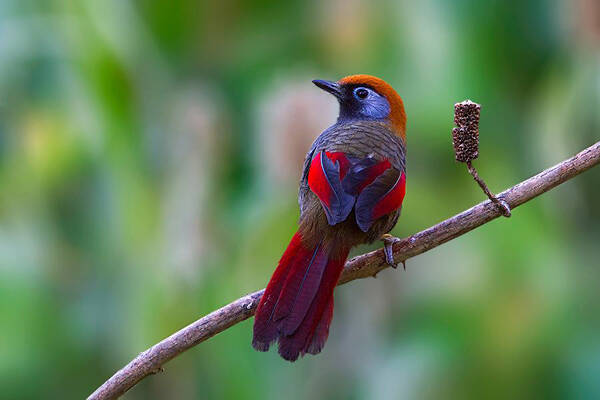Garrulax milnei
IUCN
LCBasic Information
Scientific classification
- name:Garrulax milnei
- Scientific Name:Garrulax milnei,Red-tailed Laughingthrush,Trochalopteron milnei,Red-tailed Laughing Babbler
- Outline:Songbird
- Family:Passeriformes Thrushidae Laughingthrush
Vital signs
- length:22-27cm
- Weight:66-93g
- lifetime:No verification information
Feature
The top of the head to the back of the neck is reddish brown, the wings and tail are bright red, the front of the eyes, eyebrow pattern, cheeks, chin and throat are black, and there is a gray spot behind the eyes
Distribution and Habitat
Native distribution: China, Laos, Myanmar, Thailand, Vietnam.
In China, it is mainly distributed in Sichuan, Guizhou, Yunnan, Guangxi, and Fujian.
It mainly inhabits evergreen broad-leaved forests, bamboo forests, and forest edge shrubs at an altitude of 1,500 to 2,500 meters. In winter, it also descends to low-altitude areas such as the foot of the mountain and valleys.
Appearance
The male and female feathers are similar in color, with reddish brown from the top of the head to the back of the neck, black eyes, cheeks, and eyebrow lines, gray white or silvery gray stained brown on the back of the cheeks and ear feathers, and a gray patch on the side of the head. The back is olive gray or olive green, each feather has a dark brown edge; the waist and upper tail coverts are olive green or olive yellow, the minor coverts and middle coverts on both wings are roughly similar in color to the back, the primary coverts are black, and the outer edge is red. Color, the surface of the large coverts and flight feathers are bright red, the inner feathers are dark brown, and the innermost secondary flight feathers have white spots; the surface of the tail feathers is bright red. The chin and throat are black, the upper chest is dark brown or olive yellow with gray feather edges, the lower chest, abdomen and other underparts are dark gray brown, the abdomen has a vague black en
Details
Red-tailed Laughingthrush, also known as Red-tailed Laughingthrush, has 4 subspecies.

Red-tailed Laughingthrush often moves in pairs or in small groups of 3 to 5. It is timid and good at singing. Its singing is noisy. It hides in dense bushes at the slightest movement. You can often hear its voice but not see its shadow.
The breeding season of Red-tailed Laughingthrush is from May to July. It usually nests in dense evergreen broad-leaved forests, and the nests are mostly placed on shrubs or small trees under the forest. The nest is cup-shaped, mainly composed of bamboo leaves, dead grass and some fine roots, and padded with bamboo leaves. The eggs are white with a few reddish brown or nearly black spots, and the size of the eggs is 28~30 mm × 20~21 mm.
The global population of the Red-tailed Laughingthrush has not been quantified. However, it is described as an extremely rare or rare species in its native habitat (del Hoyoet al. 2007). There are about 100~10,000 breeding pairs in China (Brazil 2009). The Red-tailed Laughingthrush population in China is rare and uncommon.
Listed in the IUCN Red List of Threatened Species: Least Concern (LC), assessed in 2012.
Listed in the "National List of Terrestrial Wildlife with Important Economic and Scientific Research Value" issued by the China Forestry Administration on August 1, 2000. (Note: Item 505 Red-tailed Laughingthrush)
Protect wild animals and eliminate game.
Maintaining ecological balance is everyone's responsibility!








